
Almería
Along the Route of the Alpujarras, Almería counted itself the most important seaport in al-Andalus; hence its defence had to be extraordinary and, consequently, Abd-er-Rahman conceived its citadel as a palace-fortress that became the most colossal building of its type in Europe.

The pages written by Pedro Antonio de Alarcón about Almería perpetuated it as a lost city in loneliness and rooted in remote times. Even by re-reading Gerald Brenan, it seems that he had neither seen it nor stayed amid its surroundings. But what really made the city distinctive was its character as a thalassocracy, which it was long before Ragusa, that is to say Dubrovnik, a free city that remained loyal to the Mediterranean when the whole of Spain dropped its patronage and headed for the adventure Atlantic.
Maybe the mountains that belted it like a shelter and the watercourses that come down through them, apparently peaceful but terrible when they become furious gullies, were of a great help. But this is exactly what conferred it the status of an open oasis to anyone arriving after rounding Cabo de Gata, the point where the waters of Mare Nostrum become Andalusian.
This has been the attribute which enabled the city to be portrayed as Istambul in the cinema, or Cairo, Messina, Palermo, a Californian city… There are hundreds Almerias which look at themselves in the mirror of celluloid portraying the same number of images.
In earlier times, when we entered into the city along the coast road that was escorted by the castle-lighthouse of San Telmo, the small tunnel on the road carved in the rock framed the citadel over the Pescadería neighbourhood; today, it is displayed from above the flyovers of the motorway, screening the sea in the background like a rosary of towers.
Over centuries, its walls of stone that housed halls, gardens, and fountains, remained sentimentally segregated from the historic centre of the city. It was as if a curse had fallen over it, and it was gradually sinking in social deterioration, surrounded by the neighbourhoods that followed the same path. Recovery, both by restoring architectural pieces like vegetal pieces and making the sound of water run again in its gardens, started in the mythic year of 1992, and it is still bearing its fruits.
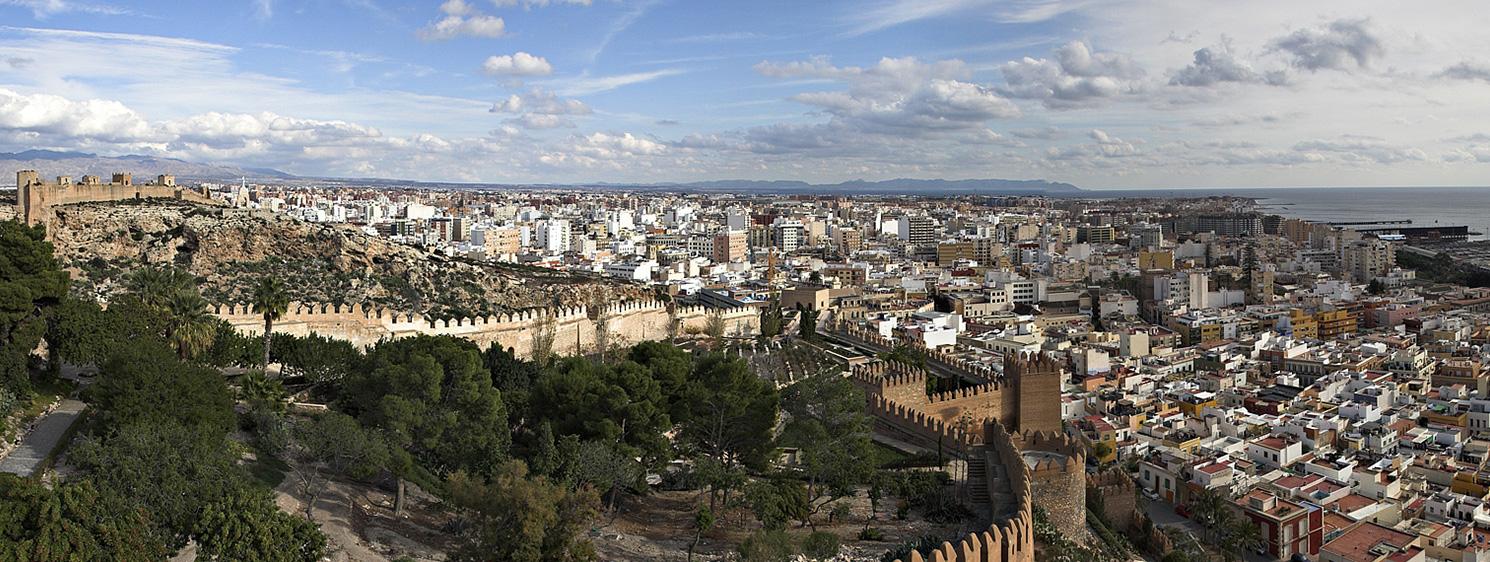
As in all the citadels of al-Andalus, this one too had its poet-king, al-Mu’tasim, who described a landscape without knowing that it was to prefigure the flag of Andalusia:
A green flag has been made
A belt with the white dawn
Spreads over you its delicious wing.
Those were the years when there existed no gap between that haughty acropolis and the city that slept at its feet. At those times, like the Hizrany in Prague, Almeria’s castle had its neighbourhood district, and this was Pescadería, which later would become a place for modest people where women painted the facades of their houses with bright colours, in imitation of those downtown, but together making a harmonious ensemble that today, to the misfortune of aesthetics and expressionist artists, there hardly remain in a few of them.
Streets come down smoothly to the Almedina, but they are formed by houses with half of one more floor in their front that in their back. This is the Decumanus of the Roman city, the arm of the cross formed between it and the Cardo from where the gate of the wall ̶ which appeared not long ago near a fishing factory ̶ and does not match with the one that would be called ̶ and still is ̶ Calle Real, “Royal Street”.
Almost perpendicular to Almedina are San Juan Street and the church of the same name. It was built on the main mosque, and during the Christian construction, a big fragment of the mihrab was hidden and preserved. It has come to light recently and its arabesques show the magnificence that this oratory must have had.
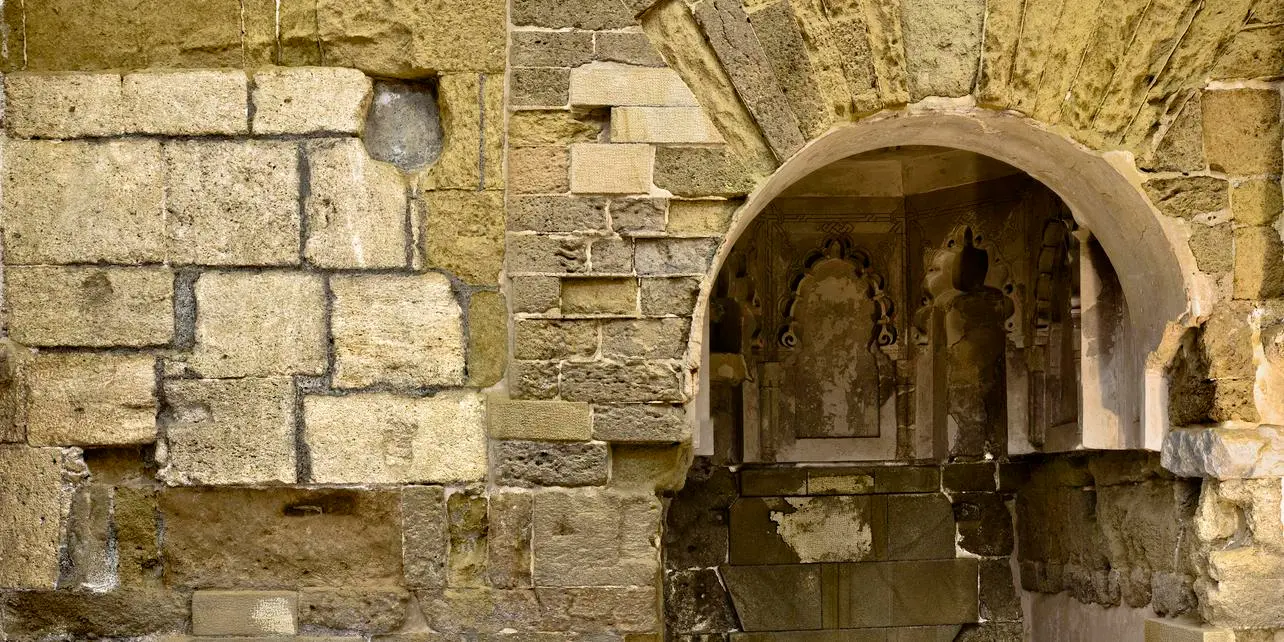
All this, within a maze of narrow streets, is now a silent city that still preserves austere mansions that still never lacks for a touch of ornamental details. They all lead to small squares, hidden by a geometry intentionally asymmetrical to protect them from wind that, from West or East, has always accompanied the city. We are in the middle of the Almeria of Federico García Lorca’s childhood, where he realised that it was still possible to write tragedies with the same pathos as the Greeks.
The two largest plazas are those of the Cathedral and the Town Hall, as if the roles had to be distributed even in the convents. Going up Real Street, leaving behind the Arquillo (Little Arch) ̶̶ the only one remaining from the many that the medina once surely had ̶ and now ready to get lost in the twists and turns of the streets, we arrive at the Plaza of the Cathedral Actually it is another fortress ready to defend, with powerful walls and a watchtower, the population from the many pirate raids that Almería suffered during the centuries of isolation.
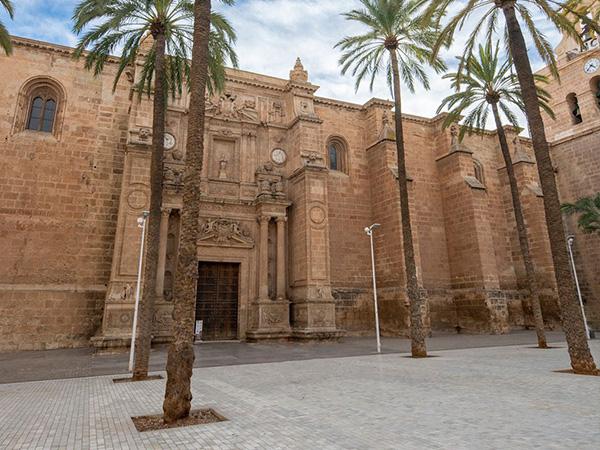
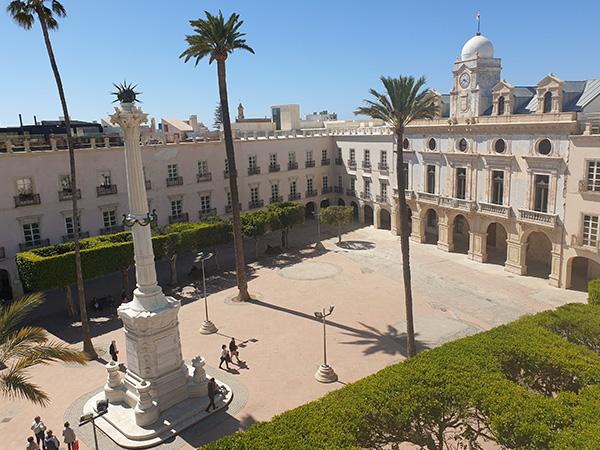
The city hall square is, paradoxically, a Plaza Mayor of a small size, which become a quiet space provided by the arcade that surrounds it and links it to both the citadel and to the modern city. In its centre stands the monument of the Coloraos (the Red ones); they constitutionalists who tried to start a Romantic revolution amid Ferdinand VII’s absolutism and who paid with their lives. It is a copy: the original ̶ which stood in Puerta de Purchena ̶ was dismantled as soon as the city was taken in the Civil War, by another absolutists.
Each one of the two squares, in order to keep their parallelism, has a convent attached: to the first one (the cathedral) we have mentioned it is that of the “Puras”, and after the second, (the city hall) that of the “Claras”.
The entrance to the Claras’ Convent is the intersection of the beginning of Real Street and Tiendas (shops) streets, ending in the church of Santiago and the façades that until recently showed the wounds from bombings during the Civil War. Here is the start of another phase of the city that has not been frequently given the relevance it deserves: Modernist Almería.
Almería has a rich catalogue of houses, and even ensembles in this style –scarce in Andalusia– that, despite its beauty is not appreciated enough.
The iron mines in Alquife, in el Marquesado region, Granada, were operated by the Scottish company “The Alquife Mines and Railways Company”. Alquife was the only place in Spain that produced iron, and the mineral was carried by train down to the port of Almeria and, from there, carried on a ship to Glasgow, where the company had its headquarters. The high iron production made necessary the building of appropriate infrastructure for shipping the material in the most efficient manner. The idea arose of building an elevated loading dock, which would allow the unloading and loading in a very easy way: the mineral would fall from the platform simply thanks to gravity. The time saved in the operation was significant.
So, the building of the so-called English Cable started in 1902, whose scale was 100 metres long and 17 high, together with the 900 metres of rail to the railway station. Some 3.8 tons of still were needed, as well as 8,000 square metres of wood and concrete. Its design was inspired in the technique used by Eiffel, who used iron pillars with traverses to ensure the stability of the ensemble.
It was inaugurated by King Alphonso XIII in 1904, and in 1998 it was declared an Asset of Cultural Interest. At present, it is in a perfect state of conservation, with a beautiful night-time lighting that enhances its presence at the Park of the Almadrabillas.
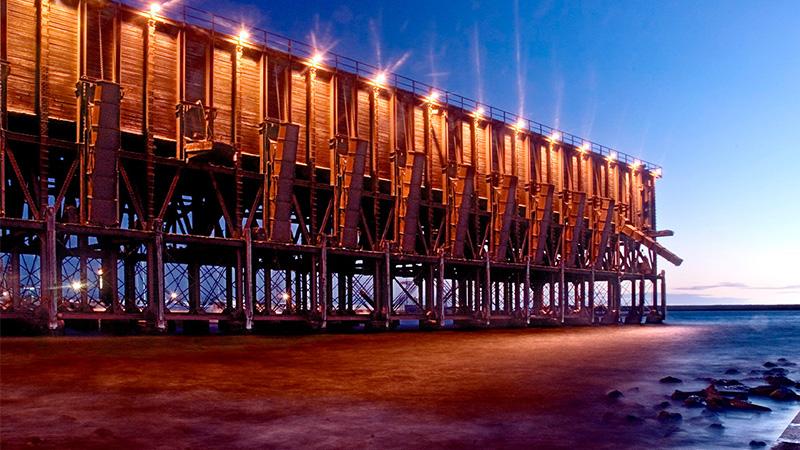
This was the time of mining and the exports of fruits to Central Europe, especially grapes, and this attracted families of engineers and merchants to the city, who tried to hold control on these businesses; these were the same years in which buildings in the style called Jugendstil were constructed in Germany and Austria. “To every time its art and to every art its freedom” was the motto that presided there the guidelines under which Otto Wagner and Joseph Maria Olbrich built, or the ones that Klimt followed when he painted the Beethoven Frieze.
There are many of these building at Puerta de Purchena, although the Casa de las Mariposas (House of the Butterflies), which at last we have found restored, stands out for its beauty and location. In the plaza, which remains the heart of the city, a statue of one of the most renowned people of Almeria, Nicolás Salmeron, the president of the First Spanish Republic, has been set as if he was walking on the street.
Modernist buildings continue along the Paseo (boulevard) as they do in the streets nearby the Rambla (dry or fearsome, which divided the city until it became a wonderful boulevard). There are further examples, like a house with a balcony featuring caryatids that might be in the very Pařížská in Prague; on the outskirts, House Fisher, with its ceilings painted by an unknown artist who surely was close to the Vienna Secession.
That Golden Age reached its end once the last mother lode was exhausted. Technicians and workers found their ways to new mining sites in Murcia, taking along the epithet that crystallised in a palo flamenco (variety of flamenco), the tarantos. This is the name of the Peña (flamenco club) that, a long time ago, brought to life the aljibes (water cisterns), which at that time were about to disappear, and there still remains plenty of cante (flamenco singing) at the very edge of the Paseo.
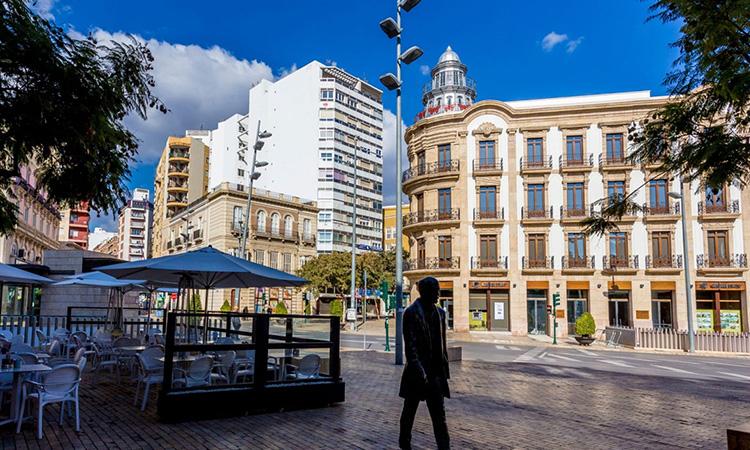
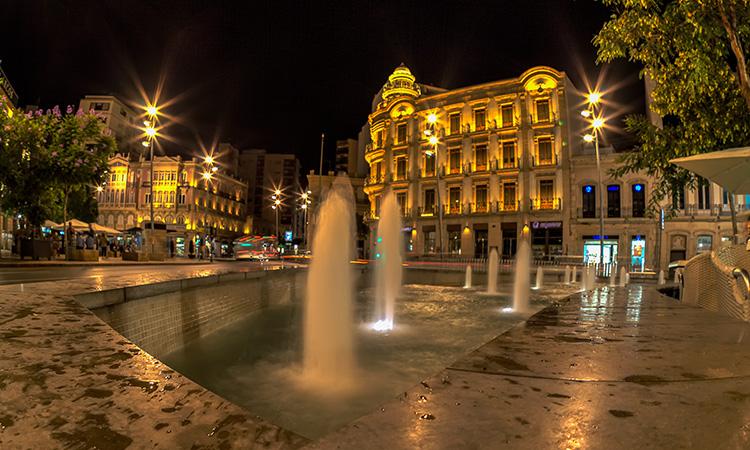
The Paseo, as its name suggests, was ̶ and somehow still is ̶ a large promenade whose terraces were filled with middle class families in the afternoons or on holiday mornings; there we can still find establishments with elegant names decorated with Austrian ingredients.
During the early seventies, the symmetry of the avenue was mercilessly trashed by urban speculation. On the lots where many nineteenth-century houses of two or three storeys –those that Pedro Antonio de Alarcón talked about into 10-storey blocks– were built with no consideration. Even today, those sharp changes in height can only be sweetened by the luxuriance of horse chestnuts that, from end to end, extend their crown over the horror.
The buildings that constituted that forum stand still: the Grand Theatre and the Casino, restored for the purpose of being the seat of the government delegation of the Andalusian Autonomous Government.
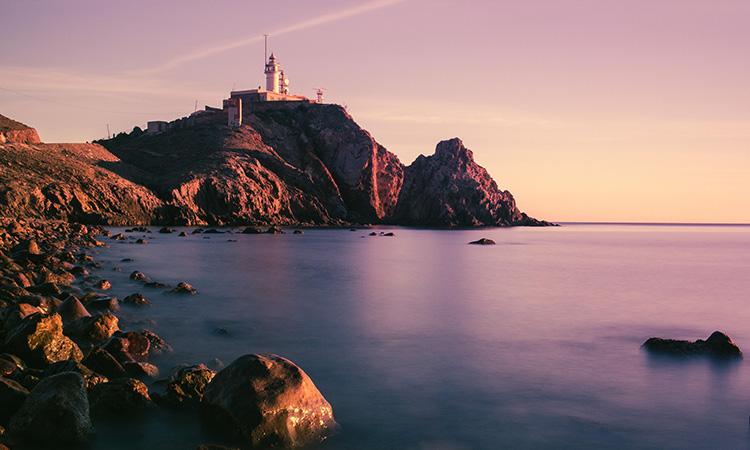
They have spread a never-ending sea
And from that sea they have made a path towards soul
Some have embarked upon the sea
From where they emerge either Muslims or Christians
In this sea with no limit to depth or shores
Prodigies and wonders are countless
Excerpt from The Book of Secrets, by Farîd Ad-Din ‘Attar, Attar of Nishapur (a Persian poet who lived in the last half of the 12th century and the first half of the 13th)
Almería, helped by vulcanos, carved in its cape the bow of a ship, that is like a hand whose fingers caress the water.
By Antonio Zoido
Writer
